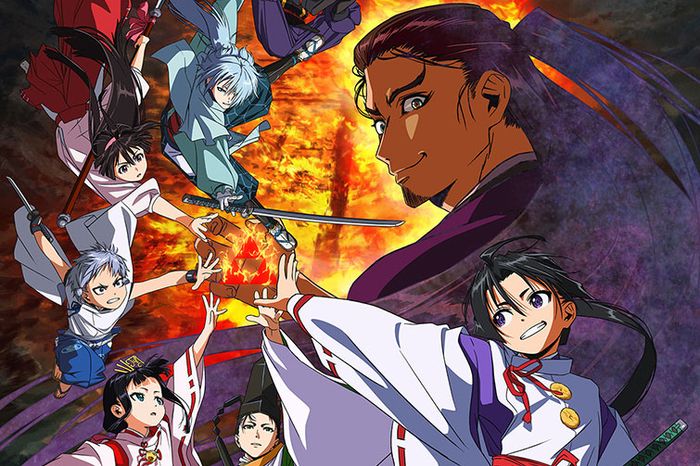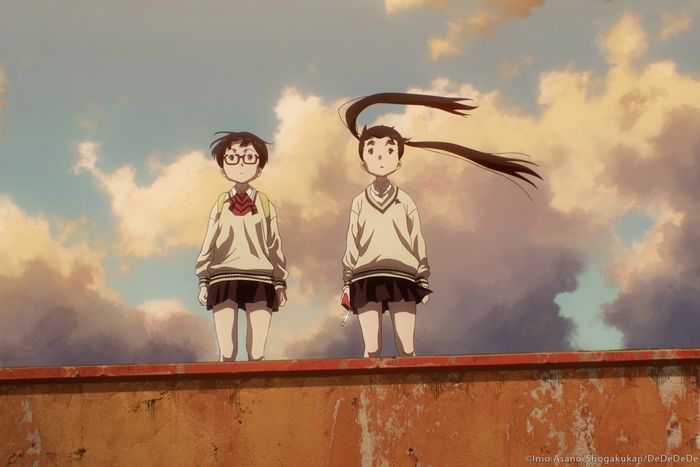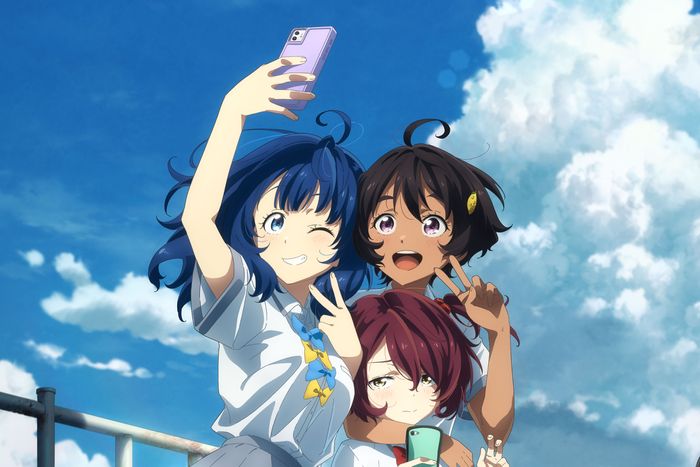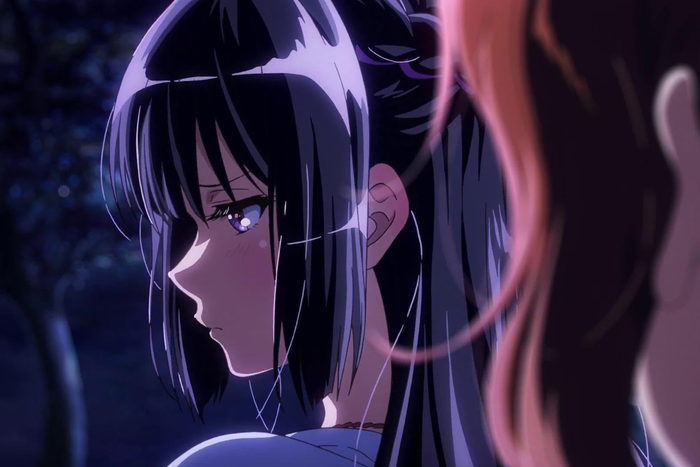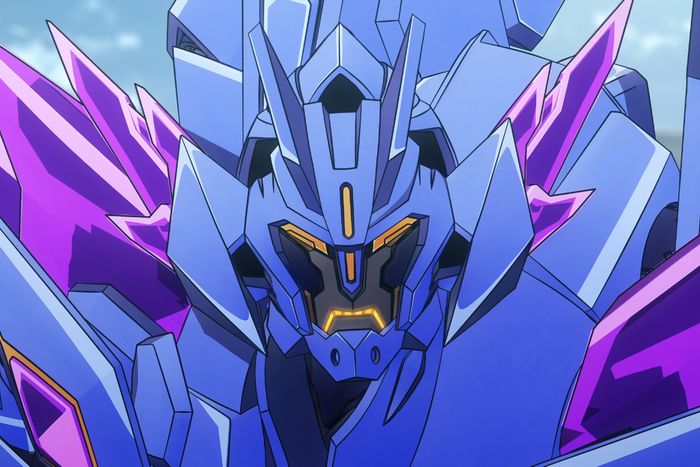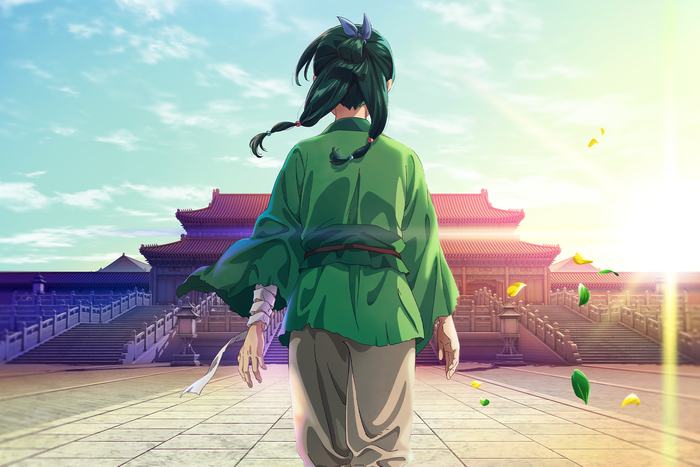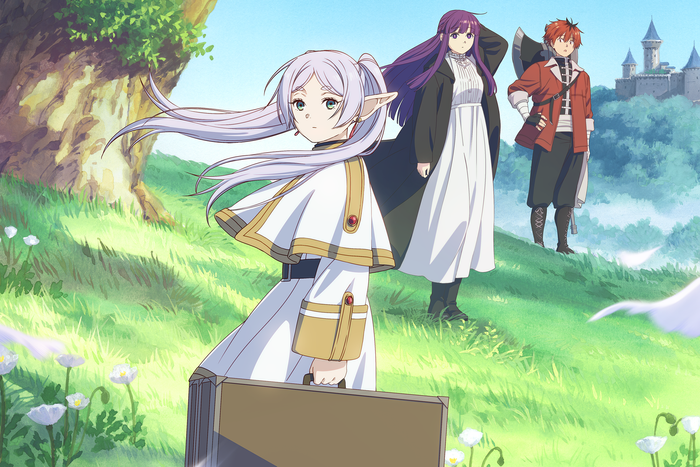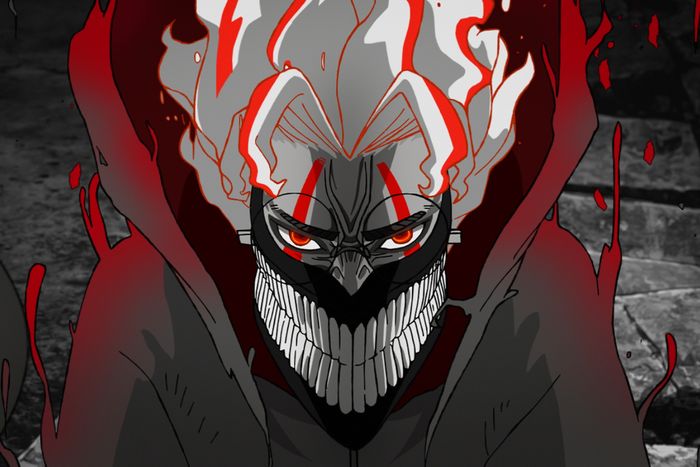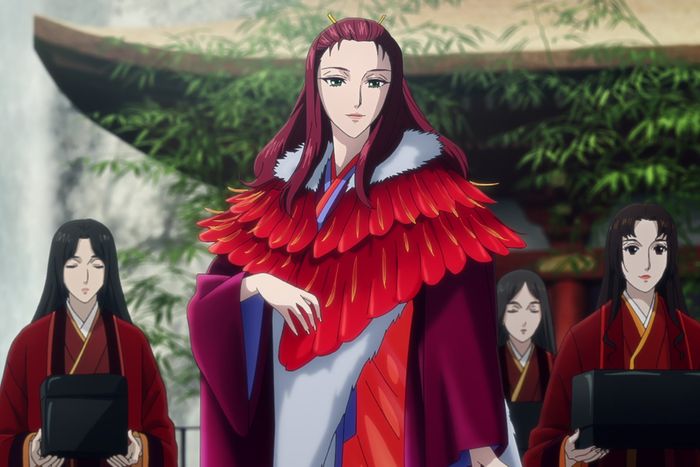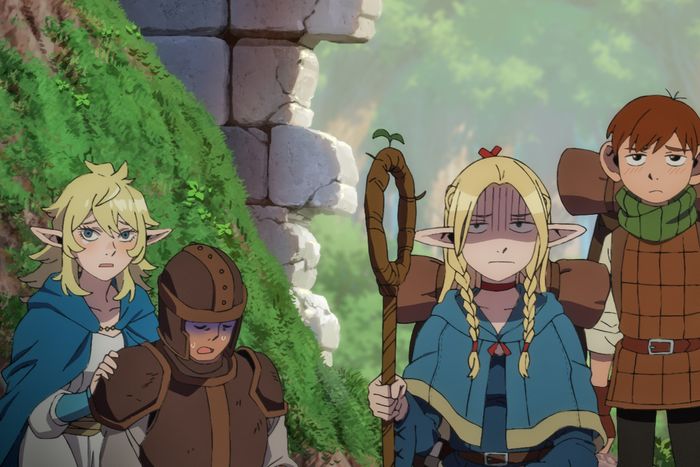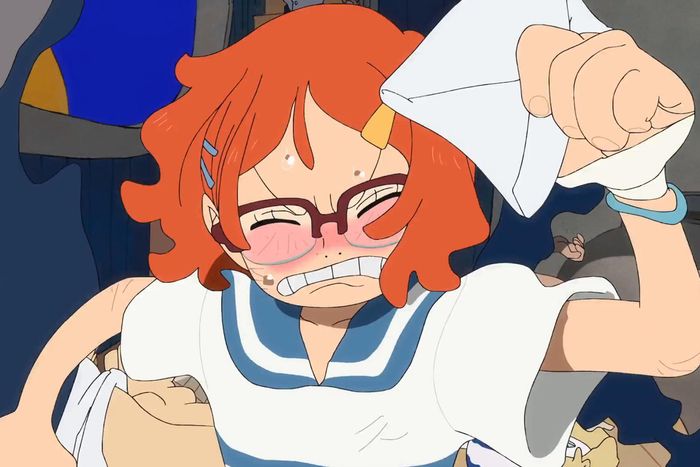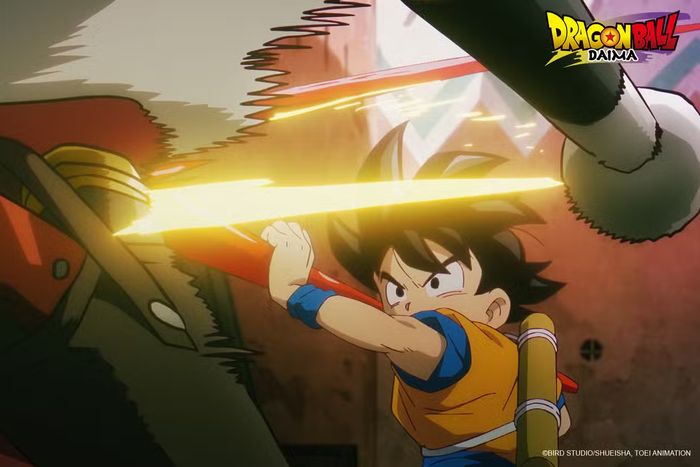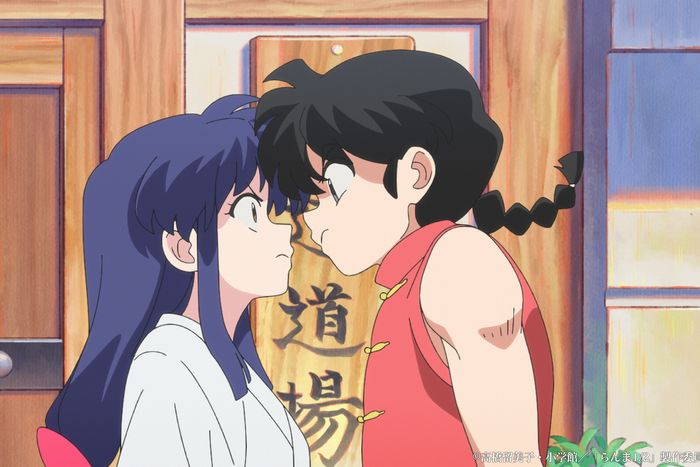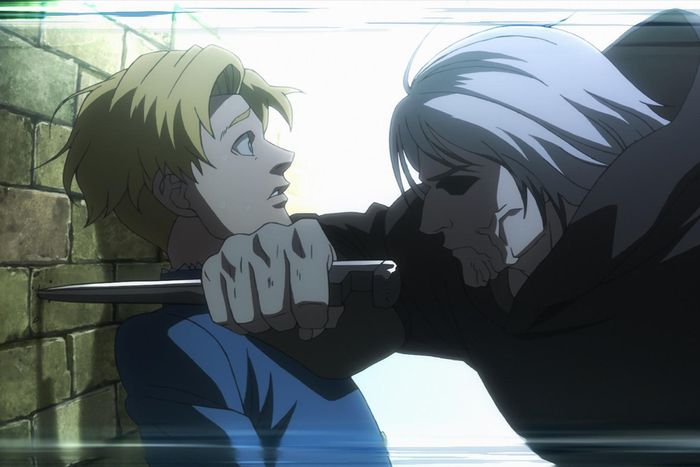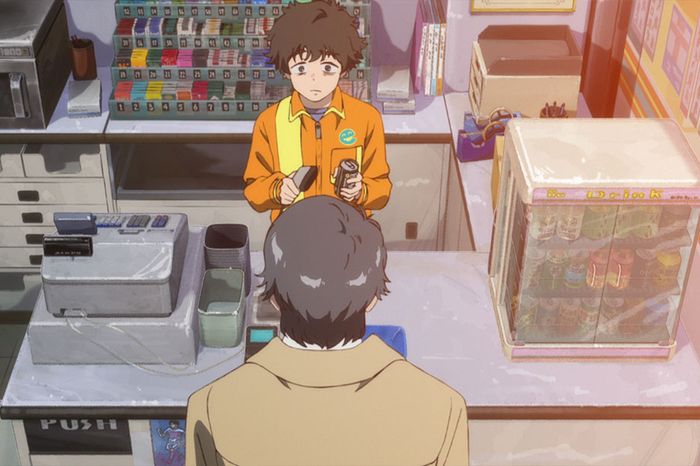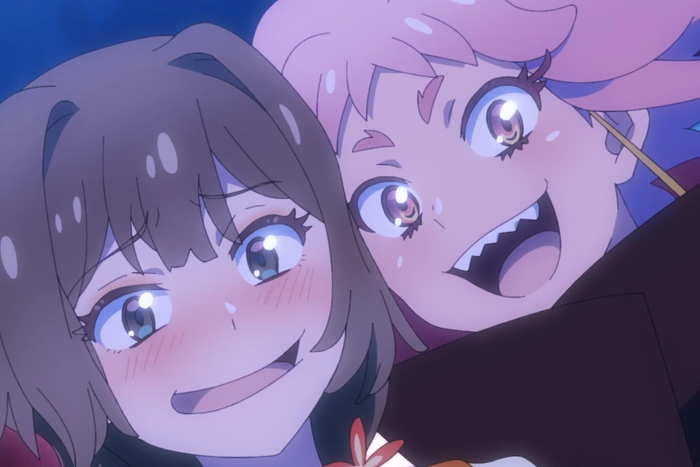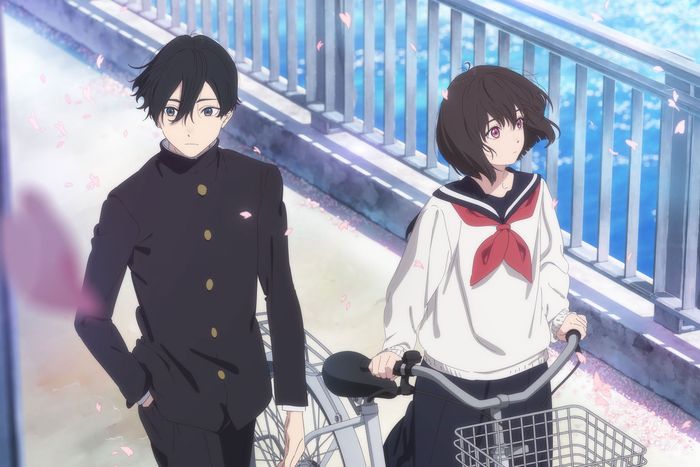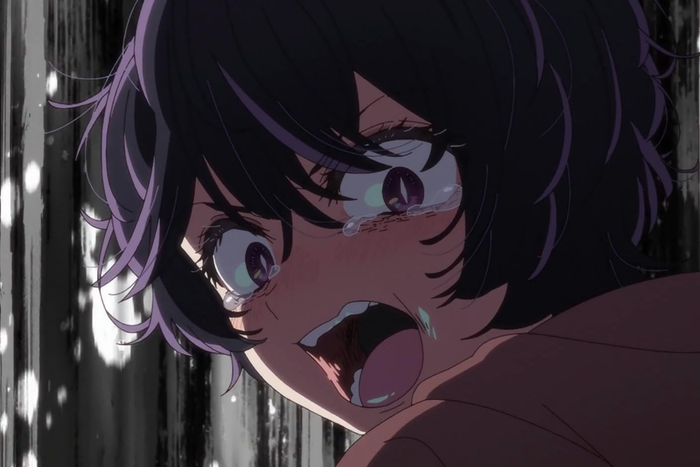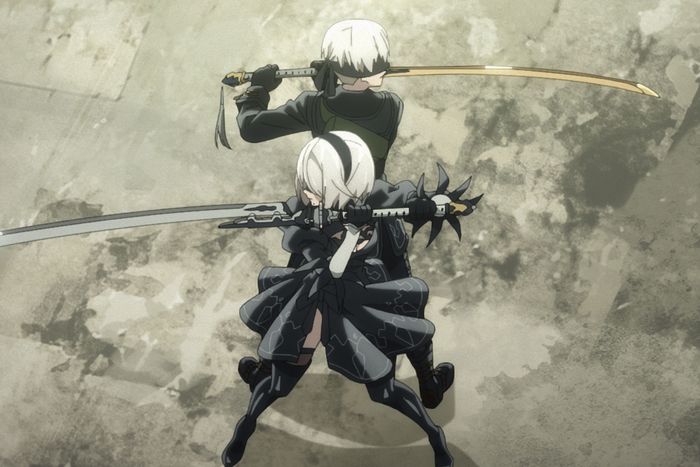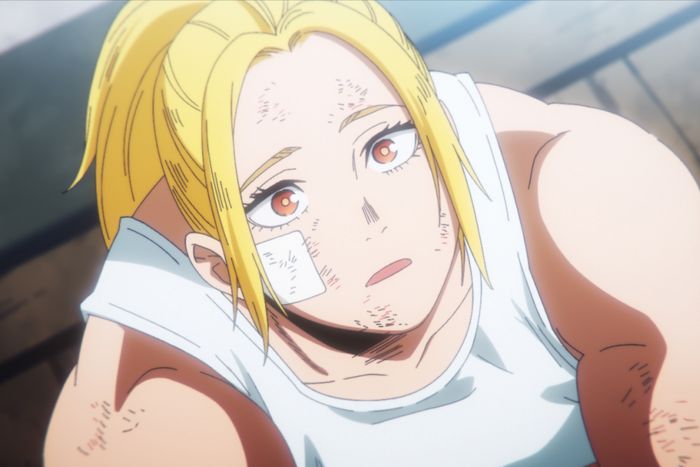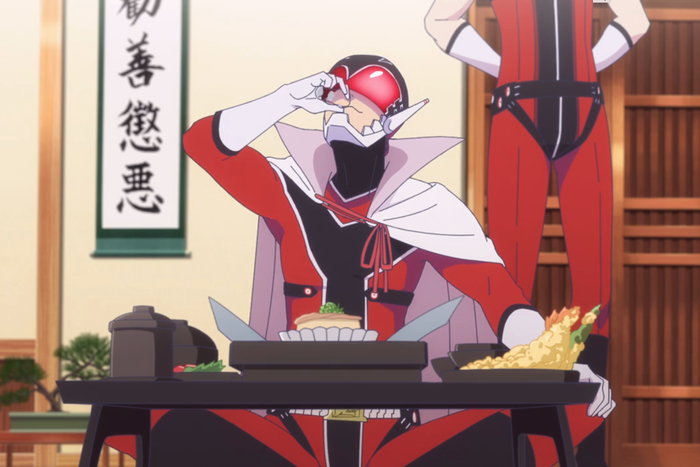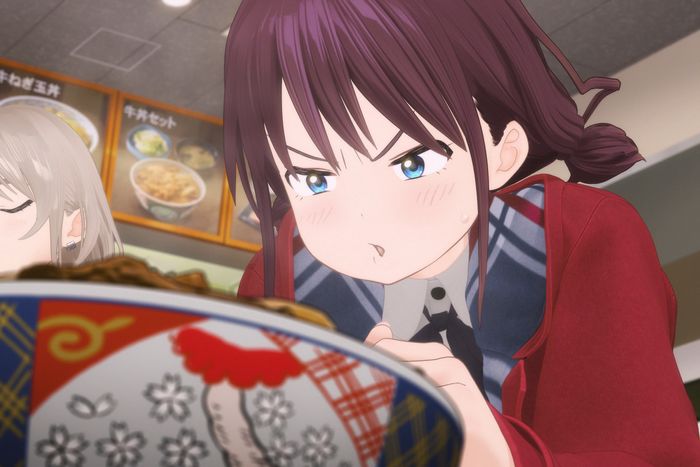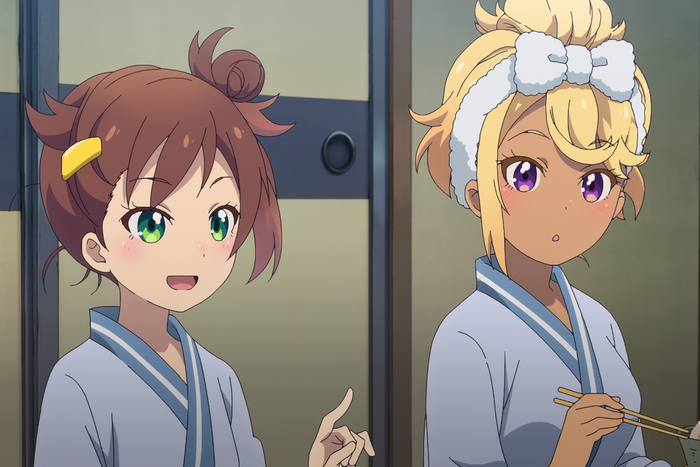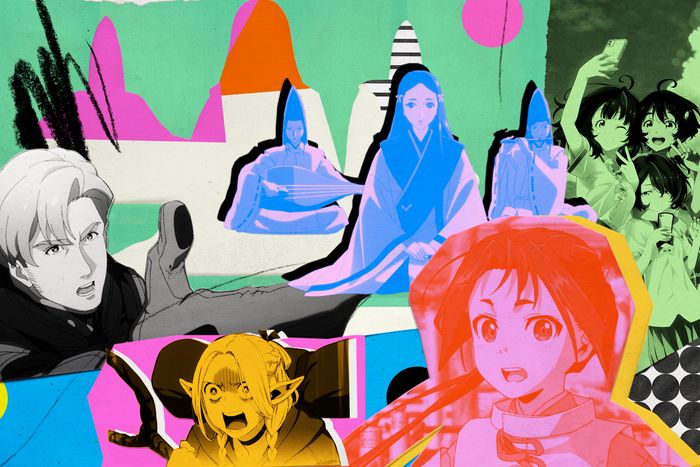
The year in anime got off to a running start. Three of 2024’s very best shows ran simultaneously with a bevy of lavishly animated and deeply considered high-fantasy series. That was only the beginning of some lovely bits of synchronicity. Next came several historical dramas playing with the real past and fictional alike. Later, old favorites made triumphant returns with Dragon Ball Daima and the pastel-colored remake of Ranma ½, comfortably sitting alongside a younger generation of exciting and idiosyncratic manga adaptations. As ever, there’s been so much great work this year that it’s almost impossible to narrow it down to a clear, decisive top ten, as some brilliant work still lies just outside those margins. Ultimately, it was the series that had the most creativity and depth to its fantasy world that came out on top.
10.
The Elusive Samurai (Crunchyroll)
The frequently goofy and energetic direction of The Elusive Samurai belies a dark story: a fictional spin on the life of the real samurai Tokiyuki Hōjō, whose family and clan is massacred by the traitorous Ashikaga Takauji in service of the Emperor dismantling the shōgunate. It displays the violence of Japan’s feudal period without so much as flinching, though it keeps a modern perspective through little meta-jokes (in the fourth episode one character frets about how a dog-shooting competition looks to the 21st-century viewer). It’s elevated by its visual craft, full of striking symbolism, while its movement is precise and detailed when it’s not playing with wildly exaggerated expressions. Not to mention it feels incredibly varied — the flourishes of action are emphasized by exciting and expressive switch-ups in art style.
As the show pivots between these stylized break-out sequences, it also switches between genuinely distressing violence to broad cartoonish high jinks enough to induce whiplash. But it’s so delightful in motion that those qualities are easy to forgive. On top of that, its joyous, rhythmic opening and ending credits are “best of the year”–worthy on their own.
9.
Dead Dead Demons Dededede Destruction (Crunchyroll)
Though I’m resisting the urge to place this series higher in the list for the alliterative potential of pairing it with No. 3 (Dan Da Dan), Dead Dead Demons Dededede Destruction is one of the finest and most underrated series of the year. The first of manga author Inio Asano’s works to be adapted to anime; it’s a darkly funny — and often just dark — visualization of how we might react to the end times.
Aliens suddenly appear over Tokyo, and the world reacts with the expected hostility and xenophobia, but after that initial chaos, that terrifying anomaly simply becomes a part of everyday living. It’s a particularly incisive show about living digitally: One character arc is a case study in radicalization through fringe online pundits. Because of that constant access to morbid and often false information, Kadode, her best friend, Ouran, and the rest of the principal cast of teenage girls both live with and live apart from the paranoia the alien ship provokes. They live like they always have but also don’t dare to think about the future, because they know they might not have one. The frenzied xenophobia and general slide into reactionary attitudes is an unsettling mirror to the real-world cultural trends festering in the 2020s. This series (dededede)deserves more attention.
8.
Makeine: Too Many Losing Heroines! (Crunchyroll)
Anime isn’t lacking for lovestruck teenagers acting like morons, but Makeine: Too Many Losing Heroines! feels like it sets the gold standard for likable doofuses making bad decisions in the name of romance. As the title suggests, the show takes interest in the losers of love triangles, untangling the complicated feelings of lifelong friendships and rivals, the humiliations of being unlucky in love, and how to move on from this rejection.
The show is empathetic and funny as it bears witness to this emotional anguish. Its main character, Kazuhiko Nukumizu, serves as a reluctant counselor to the rejected lovers. He’s all too happy to fade into the background, but this show finds its hook in how he gets swept up in everybody’s drama, whether he likes it or not. This continues to pile up throughout the season, building an ensemble cast of endearing agents of chaos who are reeling from the sting of unreciprocated love . Where Makeine’s contemporaries (like Shoshimin, which is on our longlist) searched for little moments of beauty in the halcyon days of high-school environs, Makeine runs headlong into its indignities — Nukumizu’s awareness of rom-com clichés doing little to insulate him from his weirdo high-school peers who can’t help but instigate them.
7.
Sound! Euphonium, season three (Crunchyroll)
Though moments in its story have been bridged by feature films (including the phenomenal Naoko Yamada spinoff, Liz and the Blue Bird) and an OVA, Sound! Euphonium hasn’t been released in weekly episodic form since 2016. The wait for season three proved worth it, however — from its very opening, the Kyoto Animation production is as lovely as ever. The instruments of its big band gleam with resplendent light, rendered in breathtaking detail bordering on photographic but without sacrificing expressivity for rigid realism. Its direction is well-considered — paying close attention to expressions both broad and minute, physical and facial gestures alike.
In this season, Kumiko is now the president of the Kitauiji High School band and coming to grips with leading the club that she was once just finding her footing in. Even with that new authority, the goal of winning gold in a competition comes with an emotional cost. The banter may be cute, but the show threads anxieties throughout its ensemble cast, like the nagging stress of feeling replaceable, with the pressure that there’s always someone just as (if not more) talented than you waiting in the wings. Not only that, but there are episodes that find a fascinating and delicate balance between idealism and pragmatism, between finding competitive fire without compromising the joy of actually playing. It’s a gentle show, but one grounded in believable uncertainties, tying a passion for music together with the growing pains of adolescence.
6.
Brave Bang Bravern (Crunchyroll)
Three words: gay giant robot. From industry legend Masami Ōbari comes Brave Bang Bravern!, which not only has a flashy super-robot invading the military setup of a “real robot” anime but also has that same super-robot be in love with his pilot. The boisterous sentient alien mech named Bravern comes crashing into the lives of pilots Isami and Lewis Smith, quickly forming an attachment to the reluctant Isami, leading to a man-on-robot romance for the ages.
Bravern stands out for its knowing but earnest absurdity, creating gags that could only come from an immense love for the conventions of the genre. To everyone’s bemusement, Bravern insists on yelling all of his attack moves while hilarious cutaways reveal that he plays his own theme music and projects his own logo behind him when he transforms. The show gets a lot of mileage out of its quirky giant robot that’s also a mecha otaku, passing time by building model kits in the basement and thinking of something cool to do on his next fight. (He also knows things that a giant alien robot shouldn’t: like plot devices from James Cameron’s The Abyss).
Even if you’re unfamiliar with the sorts of shows Ōbari is parodying here, it’s hilarious to see Bravern guiding the reluctant, taciturn Isami through the etiquette of being a super-robot pilot. It also boasts one of the most spectacular end-credit sequences of the year, which really should be seen rather than described. So crack open that ice-cold Kona Big Wave, and enjoy.
5.
The Apothecary Diaries (Crunchyroll)
In its second part, The Apothecary Diaries continued to impress with the depth of intrigue and world building of its clever medical mysteries. The series takes the joys of a procedural and supplants them into a faux-feudal Chinese pavilion, its main character, a young apothecary named MaoMao, working as a poison taster, then lady-in-waiting in a palace annex reserved for the emperor’s concubines.
The analytical detachment of the medical enigmas in the first part of The Apothecary Diaries take a turn for the more personal in this year’s episodes, as MaoMao’s familial ties to the palace are gradually revealed. It’s through the complications of those relationships that a new, overarching mystery is built. It’s anchored by some excellent character work; MaoMao’s process and intuition is satisfying to see in motion. The pragmatic observations that she makes connect the big picture to the personal lives of the people who are sequestered away in the pavilion, the concubines locked in a gilded cage. It’s not all so serious; the show finds levity in the playful friction between MaoMao and her supervisor Jinshi, both oddballs in their own way. For a show about medicine and poison, it sure does go down easy.
4.
Frieren: Beyond Journey’s End (Crunchyroll)
Much like the title elf herself, Frieren: Beyond Journey’s End stayed as spritely as ever throughout a rather long (28 episodes!) but captivating season. Where the first half of the season was split into smaller quests, the second expands into a longer arc. It turns out that Frieren, in her centuries-old age, doesn’t have any kind of government-supplied proof of her aptitude for magic. Frieren and her longtime protégé, Fern, sign up for the test and meet a host of colorful new characters.
In its first part, Frieren was one of the most beautifully made anime series of 2023, and it continues to be in its second, even if it feels as though it drifts toward more standard fantasy. This half lost some of the melancholy of the first, which perhaps makes the series fall short of the uniqueness factor of Delicious in Dungeon (see below), but its more traditional adventuring still proved winsome. Under the eye of series director, Keiichirō Saitō (Bocchi the Rock!), the visual presentation is immaculate, with painterly backgrounds and articulate character animation, as well as a delightful score from Evan Call with sounds that feel ripped from the past: fitting for a show about a bookworm who is over 1,000 years old.
There’s a healthy split between quiet introspection and kinetic, smartly choreographed action spectacle. The new arc leans into this excitement with a renewed focus on mage combat, with fights that unfold like hyper-mobile battleships moving against each other, spells unleashed with sudden explosive power. Watching these psychos size one another up is fun, yet the show never feels taken over by blunt force and spectacle. At its core, Frieren is still a show about time threatening to leave you behind, something it tackles in ways both small and frighteningly big.
3.
Dan Da Dan (Netflix, Crunchyroll)
A show that’s horror-meets-sci-fi-meets-action-meets-romantic-comedy, Dan Da Dan is a lot. But it handles its many digressions with grace, both on the page and in Science Saru’s adaptation. Each episode tackles the paranormal with an irreverent and raunchy sense of humor, utilizing Saru’s typically loose animation style, bold color choices, and art direction as it adapts Yukinobu Tatsu’s hit Shonen Jump comic. With its interests in the arcane, its pulsing score from Kensuke Ushio (who at one point pulls out an astonishingly funny dance remix of Rossini’s “March of the Swiss Soldiers”) and a character with the demonic power of running really fast, it overlaps a little with the studio’s Devilman Crybaby. Still, Dan Da Dan combines so many things — actual folklore with a long list of cultural obsessions beginning with Ultraman and acting legend Ken Takakura — to the point that it feels completely one of a kind.
The series starts with two teenagers, Momo Ayase and Ken “Okarun” Takakura arguing over whose occult belief is real. It turns out they both are, as one gets abducted by a yokai and the other by aliens. Once that wild prologue is over however, Dan Da Dan turns its (evil) eye to a story just as unhinged: Poor Okarun finds out after his paranormal encounter that his balls are missing, and so the hunt begins to get them back. If this all sounds juvenile, that’s because it is, and willfully so. But there are things that Dan Da Dan treats seriously and with sincerity like its tender central relationship, which is where Dan Da Dan gets its real fire; the friendship between Momo and “Okarun” has the beginnings of a genuinely sweet romance. A standout seventh episode demonstrated the show has higher ambitions still: using a unique perspective to explore the morbid tragedies of ghost stories, interested in the friction between folklore and the modern day. All this from a show about incomprehensible forces preventing a teenage boy from getting his balls back.
2.
Yatagarasu: The Raven Does Not Choose Its Master (Crunchyroll)
There may be more visually sumptuous animes this year, but Yatagarasu: The Raven Does Not Choose Its Master is almost unrivaled as far as writing goes. It begins like a fable: A boy and his ailing brother are rescued by a man who can turn into a giant golden raven, only for the boy to forget it ever happened though they’re fated to meet again. But this is also the beginning of the series’ various tonal and narrative twists, as it quickly turns from that idyllic setting to a cold war for succession, with various people around the palace and its less affluent surroundings caught in the crossfire. Yatagarasu patiently and deliberately creates a compelling court drama in which the ritual, ceremony, and propriety are covers for the same ugly human impulses that are anywhere else.
The series is set in Yamauchi, a country split into four houses with a mountain palace unifying them in the middle. Ruling over it is a hereditary monarchy, the descendants of Yatagarasu, mystical three-legged ravens (named for the Shinto god) that could turn into humans, ones that built the lands their descendants now squabble over. The monarch is always the k’inu, a golden raven. Everyone else jostles for whatever power they can grab. That push and pull is shown with propulsive momentum, each episode a revelation about the truth of the fictional world being built, simple conversations and monologues transforming into edge-of-the-seat thrills.
1.
Delicious in Dungeon (Netflix)
This adaptation of the excellent Ryoko Kui manga from Studio Trigger (Cyberpunk Edgerunners) and director Yoshihiro Miyajima quite literally makes a meal out of the logistics of tabletop fantasy RPGs, with its main cast learning how to cook monsters in order to survive a trip down to the lowest depths of an incomprehensibly large dungeon. After a disastrous encounter with a dragon that results in his sister being eaten alive, the human Laios, the elven mage Marcille, and the halfling Chilchuck venture back into the dungeon to rescue their comrade with the assistance of the dwarven cook and forager Senshi.
What follows is part traditional fantasy adventure, part cooking anime as each episode — titled after whatever meal they’re having — follows the gang through the unique environment of each new level of the dungeon. The show’s second half, however, is where the real meat of the series is: While still structured around culinary antics, it includes compelling and expansive fantasy world building as the party stumbles across long dormant mysteries about the foundation of this underground world.
It has such a strong and unique sense of identity, one that stands out even as it juggles action, comedy, and horror — all of the food groups! — not to mention a sense of genuine wonder in the exploration of each layer of the dungeon. It’s the same appeal as Kui’s manga, in which every chapter is artful and funny and brings something new and exciting, brought to life expressively both in its artwork and in its dynamic, laugh-out-loud voice performances in its subbed and dubbed versions alike. It arrived early in 2024, but there’s no other show that reached the hilarity, creativity or depth of the five-course anime meal that is Delicious in Dungeon.
Other Anime Highlights from the Year
Throughout 2024, Vulture maintained a “Best Anime of the Year (So Far)” list. Some of those selections appear above in our top-ten picks; below are more series that stood out this year, listed by premiere date with the newest releases up top.
One Piece Fan Letter (Netflix, Crunchyroll)
It feels strange to highlight a single special episode of one of the longest running manga and anime series of all time (the arc before the current one is 208 episodes). But One Piece Fan Letter, even to someone relatively unfamiliar with its expansive story, is a wonderful encapsulation of both the series irresistible charms as well as the talents of its beloved director Megumi Ishitani.
It sees Luffy and his Straw Hat Pirates from an outsider perspective, both that of a young girl who idolizes the Straw Hats’ navigator, Nami, and that of a marine who feels indebted to Luffy for saving his brother’s life. There’s an infectious sense of nostalgia and adventure driving the piece, Ishitani capturing and expanding upon the warmth of manga creator Eiichiro Oda’s story as well as his intricate world-building. Everything feels so full of life, every sequence bursting with energy and color as it details how the larger-than-life main cast affects people that they’ve never met. It’s one of the best single episodes of the year, one that may convince even the One Piece agnostics that they’re fans too.
Dragon Ball Daima (Netflix, Crunchy Roll)
Following the death of Akira Toriyama, it feels fitting that the latest Dragon Ball adventure is a refreshing sort of back to basics, returning Son Goku to the tiny stature of his first-ever appearance.
Ranma 1/2 (Netflix)
This remake of the 1989 anime — in which a martial artist turns into a girl whenever he’s splashed with cold water — follows in the footsteps of the recent, also pastel-toned Urusei Yatsura (2022), capturing the influential style of manga legend Rumiko Takahashi for a new generation of viewers. Cute, colorful, and as witty as ever.
Orb: On The Movements of the Earth (Netflix)
For a series about the discovery of the heliocentric model, Orb: On The Movements of the Earth gets extreme almost immediately. It begins with someone’s fingernails being pulled out, establishing early the lengths to which the ruling “C religion” (Catholics) will go to shut down the propagation of astronomical ideas in “the Kingdom of P” (Poland). This adaptation of Uoto’s historical-fantasy manga builds drama from the attempted suppression of scientific theories that would threaten Christian sovereignty, based around the narcissistic belief that the whole universe was created by God for man alone.
The history of this scientific suppression is used loosely as a jumping off point, following heliocentrism across time and an ensemble cast of characters, separated by decades, seeking the truth of the universe almost against their own will. The aforementioned brutal violence exists to show the conviction of these “heretics,” spotlighting the importance of integrity in the face of a tyrannical institution.
Negative Positive Angler (Crunchyroll)
Like the oxymoron of its title, fishing anime Negative Positive Angler spins a surprisingly miserable opening (a destroyed home, crippling financial debt, after a botched suicide attempt and a terminal illness diagnosis) into a pleasant, low-stakes hangout show about how it’s never too late to try something new.
Mayonaka Punch (Crunchyroll)
A new and expectedly anarchic original series from the studio P.A. Works — known for creating the incredible yakuza parody Akiba Maid War and others — Mayonaka Punch delves into the livelihood of YouTubers (here called “Newtube”), but with the added absurdity of it also being about vampires. Directed by Shū Honma (Ya Boy Kongming, another show about contemporary culture from the perspective of people out of time), it begins with Masaki being booted out of her group of streamers, publicly shamed for punching one of the others on live video.
With its unruly house of misfit undead and one human documenting their actions, it plays like if What We Do in the Shadows was about the absurdity of content creation. Masaki is desperate and ruthless in her hunt for views, and her vampire comrades are mostly clueless about it thanks to their different relationships with time. Like Akiba Maid War before it, Mayonaka Punch is crammed with little in-jokes and references (one fight ends with a vampire left in a crater like Yamcha), though this is less about genre homage than it is about playing with the contrast between the eldritch powers of its cast and the petty struggles of making a name for yourself online.
Shoshimin: How to Become Ordinary (Crunchyroll)
Following in the soft footsteps of Hyouka — this is based on novels by the same author, after all — Shoshimin: How to Become Ordinary packages coming-of-age insecurities in an easygoing mystery format. Kobato and his friend Osanai have recently entered high school, and they don’t want to stick out — that aspiration toward mundanity reflected in the show’s sense of reserve, through naturalistic designs and patient pacing. Such restraint and emphasis on the “ordinary” doesn’t mean its visuals don’t stand out — the animation produced by studio Lapin Track favors a wide aspect ratio that immediately sets it apart.
The score is used sparsely, leaving plenty of room for genuine quiet between its character’s contemplations and problem-solving exercises. Even the mysteries themselves are incredibly low stakes: a missing bag (with nothing valuable in it), a reverse-engineered recipe, little slices of life that invite questions that perhaps allow Kobato to reflect more on how he wants to change himself. These little conundrums are charming glimpses into the behaviors of the students.
Oshi no Ko, season two (HiDive)
In practice, Oshi no Ko is a lot more down to earth than its completely unhinged premise sounds on paper. Aqua and Ruby, the secret twin children of famous idol Ai Hoshino, also happen to remember their previous lives: Aqua was a doctor who treated Ai, Ruby was a terminally ill fan of hers. After being reincarnated as her children, Ai is murdered by a stalker. Regardless, the two grow up with aspirations toward the entertainment industry — though Aqua does it to seek revenge on the man who leaked Ai’s address to her killer, a man he suspects to be his father.
Really, though, the show is mostly about the ins and outs of the Japanese entertainment industry — the first season immerses itself in the production of a reality show and then in idol culture. The new season dives into a rather unique space — theater. More specifically, “2.5-D” theater, which mainly deals in the adaptation of manga, but this particular project is more high-tech than the usual.
The show’s splashy presentation and delicate character designs hide a darker underbelly, entangling the ugly side of entertainment with Aqua’s single-minded revenge mission. The show is so engaging in the emotional and technical details of entertainment you could be forgiven for forgetting about its main characters’ utterly wild biographies. The theater arc also delves into other connecting industries, one episode honing in on the pains of adaptation and even the process of creating manga, an arc which feels particularly personal from the series’ original author.
NieR Automata Ver1.1a, season two (Crunchyroll)
Video-game adaptations are often a tenuous prospect. Some stories don’t land the same without the tactile input of a controller and player choice, and NieR Automata feels like a particularly risky choice as it’s expressly concerned with the story experiences that only games can provide, this particular tale creating melancholy out of the loops and repetition inherent to the medium.
Like the game, the show is set in the far future when androids fight on behalf of humanity in a proxy war with alien invaders, who themselves deploy an army of robots. The events of Automata are seen through the eyes of the doll-like androids 2B and 9S, part of a vaguely fascistic special force named YoRHa. Both sides go through painful transformation, grasping at imitations of human behaviors.
Though the pilot episode felt like a false start, it quickly became clear that director Ryouji Masuyama wasn’t interested in simply lifting things directly to the new format (the game’s director, Yoko Taro, is also involved). Some details of the story have been changed, expanding on smaller side stories as well as reconfiguring the game’s dual perspectives — elaborations that make the game’s tragedies sting just that little bit more. There’s also some fun, original touches, the most delightful of which is a recurring post-credits puppet show that reenacts the game’s multiple joke endings, as well as adding some new ones. After the show’s initial stumbling blocks, Automata has gathered itself together as an interesting adaptation for fans and newcomers, adding enough to keep the story feeling fresh, embracing the game’s flexible approach to narrative.
My Hero Academia, season seven (Crunchyroll)
The blockbuster superhero anime approaches its endgame in its seventh season by adapting Kohei Horikoshi’s manga. The world of My Hero Academia echoes that of the X-Men, except people born with powers are the majority rather than the minority. Main character Izuku “Deku” Midoriya was one of the few born without a special ability, until the fateful day he met his hero, who chose him as his successor and gave him his power, named One for All — a combination of the abilities of its previous eight users, Avatar style, including super-strength, flight, and the ability to sense incoming danger.
In between its moments of spectacle and shonen grandstanding, My Hero Academia pays close attention to the sociology of a world inundated by fantastic powers. Super-heroism has become the norm — for some, it’s the family business — and such entrenched hereditary power has led to its own problems, with the previous generation having made numerous moral compromises to maintain the peaceful status quo. Those chickens have finally come home to roost, with the skirmishes between Deku and the League of Villains spiraling into all-out war, even reaching foreign shores. That’s right, the USA finally gets involved with a hero named (what else?) Star and Stripe wielding the power to impose rules over anything she observes. Winking, blunt-force allegories for imperialism aside, it’s exciting to see the show swing for the fences in its big final arc.
Go! Go! Loser Ranger!(Hulu)
Based on the manga by Negi Haruba, Go! Go! Loser Ranger! inhabits the point of view of an anonymous henchman as he seeks to take down the dominant and corpo-fascist Super Sentai–esque heroes from the inside. Every Sunday for 13 years, the heroic Dragon Rangers have fought invading alien monsters from a floating fortress — only the Rangers won long ago, and these battles are essentially predetermined for live television, with the monsters forced to maintain kayfabe under pain of death. The battles staged are effectively Saturday-morning children’s programming as propaganda. During one of these battles, Fighter D slips away and assumes human form in order to infiltrate the organization of his oppressors. It’s not so much a fight for justice as it is a spectacle for ratings — the Rangers, here a vast military operation, keeping up a facade for their adoring fans where the monsters see them for what they are: vain sadists. D’s mission to beat the Rangers picks up some unlikely companions, but whether they’re on his side or not, everyone in Loser Ranger is completely, compellingly unhinged.
Girls Band Cry (Crunchy Roll)
One of the tricky things about covering anime each year is that, well, some of the best stuff simply doesn’t get a proper international release. A couple years ago, Summertime Rendering missed out on our list because Disney simply sat on releasing the show until it was too late; anime fans have long referred to the company’s purchasing of licenses as “Disney Jail” for a reason. This year, it’s Girls Band Cry’s turn to have its potential viewership kneecapped; rather than weekly releases on streaming, the show’s English release was originally only available via digital purchase on Amazon (though now, thankfully, its on Crunchy Roll).
The show follows Nina Iseri, a 17-year-old high-school dropout from the country on her way to Tokyo. She quietly rages at her overbearing parents, her bullies, and herself, a mood which radiates off her in red and black lines that almost look like flames. As fate would have it, she meets her favorite musician, Momoka, who herself is about to drop everything and quit the business. After hitting it off and getting in trouble together, and even becoming odd-couple roommates for a minute, they start a band.
As for its look, CG animation has a bad rap in anime, but the animation of Girls Band Cry is energetic and creative enough that the blemishes (incredibly smooth-looking cats, some awkward movement, and lip syncing) can be overlooked. In short, Girls Band Cry is a show that’s far too fun to be forgotten about on dusty digital shelves.
Train to the End of the World (Crunchyroll)
An original anime from Tsutomu Mizushima (Shirobako), Train to the End of the World is a strange but often sweet road trip across a transformed Japan. The circumstances of that transformation is patently absurd, playing on contemporary conspiracy madness: The launch of “7G” twists the landscape into surrealist shapes and changes the laws of nature, effectively ending civilization as we know it. Some time later, rather than shelter in place in their hometown of Agano, a group of girls — Reimi, Shizuru, Akira, and Nadeko — have to brave the unknown to recover their childhood friend Yoka.
The effects of the 7G explosion are entertainingly unpredictable. In Agano, all the adults have turned into animals. At one of their next stops, mushrooms spout from people’s heads; later, strange goat men that “look like Baphomet” ram the train’s carriages. I’ll leave some of the weirdest changes as a surprise. The trip down the (supernaturally long) train line is characterized by great banter and bickering among its cast as well as a latent creepiness that slowly moves into the foreground. Even with its little bursts of horror, Train to the End of the World is soothing viewing regardless, remaining funny and optimistic even in the face of the end.
A Sign of Affection (Crunchyroll)
A syrupy sweet romance about communication, A Sign of Affection follows the tentative courtship between university students Yuki and Itsuomi. Yuki is deaf, so along the way she teaches Itsuomi, a keen linguistic scholar, how to speak Japanese Sign Language.
Beyond the sweet crush between its principal characters, A Sign of Affection rounds out its cast with a range of angsty and beautifully drawn 20-somethings with varying chips on their shoulders and romantic anxieties. (Seriously, these are some of the most beautiful people ever drawn.) Tried-and-tested shojo clichés — the spurned childhood friend, for example — are here, but they maintain dramatic weight and a sense of emotional complexity. There are some moments where its day-to-day drama becomes unintentionally funny, like Yuki looking completely awestruck at a Costco (to be fair, they’re university students, and anyone would be thrilled by the store’s gigantic tiramisu). Otherwise, the show has a cute sense of humor and an almost sickly romantic temperance, perhaps an acquired taste for some. But for those who do appreciate such unabashedly sentimental anime, A Sign of Affection will go down smooth.
.
Worth Mentioning
Uzumaki (Adult Swim, Max)
Well, we got a solid 25 minutes. Uzumaki may have had the most severe decline in quality in recent anime history — not just in terms of animation quality, but also in its unsteady grasp of timing and story pacing, as it unceremoniously rushed through the vignettes of Junji Ito’s manga. Considering that the production, vaguely speaking, seems like it was as horrific as the source material itself, perhaps that rush to get it over with makes some level of sense.
It’s a huge disappointment compared to the promise of that eerie and beautifully animated first episode, which proved atmospheric as well as thoughtful in its unique visual approach. It turns out, this was unsustainable — this writer should not have trusted that the premiere would be representative of the rest. While Uzumaki was originally included in this “Best of 2024” list based on the premiere’s strength, we’ve since relegated it to this spot. As for what happened, maybe time will tell what went wrong with production. “Cursed” is probably the right word for it, the result being a rather bracing (and embarrassing) lesson in not falling for the hype.
➽ Read Eric Vilas-Boas’s list, “The 22 Scariest Horror Anime of All Time.”


